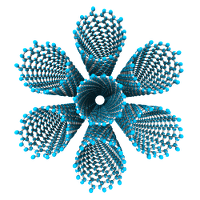Source code for sknano.generators._mwnt_generator
# -*- coding: utf-8 -*-
"""
===============================================================================
MWNT structure generator (:mod:`sknano.generators._mwnt_generator`)
===============================================================================
.. currentmodule:: sknano.generators._mwnt_generator
"""
from __future__ import absolute_import, division, print_function, \
unicode_literals
__docformat__ = 'restructuredtext en'
# import copy
# import numpy as np
# from sknano.core import pluralize
# from sknano.core.math import Vector
from sknano.structures import MWNT
# from sknano.core.geometric_regions import Cuboid
from ._base import GeneratorBase
from ._swnt_generator import SWNTGenerator
__all__ = ['MWNTGenerator']
[docs]class MWNTGenerator(GeneratorBase, MWNT):
"""Class for generating single, `MWNT`.
.. versionchanged:: 0.2.20
`MWNTGenerator` no longer generates MWNT *bundles*, only *single*
MWNTs. To generate bundled MWNT structure data, use the
`MWNTBundleGenerator` class.
.. versionadded:: 0.2.8
Parameters
----------
Ch_list : :class:`python:list`, optional
(:attr:`~SWNT.n`, :attr:`~SWNT.m`) for each `SWNT` wall in `MWNT`.
Nwalls : int, optional
Number of `SWNT` walls in `MWNT`.
Lz : float, optional
`MWNT` length in **nanometers**.
min_wall_diameter : float, optional
Minimum `MWNT` wall diameter, in units of **Angstroms**.
max_wall_diameter : float, optional
Maximum `MWNT` wall diameter, in units of **Angstroms**.
max_walls : int, optional
Maximum number of `MWNT` walls.
chiral_types : {None, 'armchair', 'zigzag', 'achiral', 'chiral'}, optional
If `None`, the :attr:`~SWNT.chiral_type` of each `MWNT` walls
will be random and determined by the set of randomly selected
chiral indices (:attr:`~SWNT.n`, :attr:`~SWNT.m`).
wall_spacing : float, optional
Inter-wall spacing in units of **Angstroms**.
Default value is the van der Waals interaction distance of 3.4
Angstroms.
autogen : bool, optional
if `True`, automatically call
:meth:`~MWNTGenerator.generate`.
basis : {:class:`python:list`}, optional
List of :class:`python:str`\ s of element symbols or atomic number
of the two atom basis (default: ['C', 'C'])
.. versionadded:: 0.3.10
element1, element2 : {str, int}, optional
Element symbol or atomic number of basis
:class:`~sknano.core.Atom` 1 and 2
.. deprecated:: 0.3.10
Use `basis` instead
bond : float, optional
:math:`\\mathrm{a}_{\\mathrm{CC}} =` distance between
nearest neighbor atoms, in units of **Angstroms**.
verbose : bool, optional
if `True`, show verbose output
Examples
--------
>>> from sknano.generators import MWNTGenerator
>>> MWNTGenerator(Nwalls=5, min_wall_diameter=10, Lz=5).save()
The above command generated a 5 wall, 10 **nanometer** long `MWNT`.
The only constraints on the `MWNT` wall chiralities were the diameter
constraints imposed by the `min_wall_diameter` parameter,
which set the minimum wall diameter to 10 Angstroms,
as well as the minimum wall-to-wall separation, which
defaults to the van der Waals distance of 3.4 Angstroms.
This `MWNT` chirality may be written as:
:math:`\\mathbf{C}_{\\mathrm{h}} = (8,7)@(17,8)@(9,24)@(27,18)@(22,32)`
Here's a colorful rendering of the generated `MWNT` structure:
.. image:: /images/5wall_mwnt_(8,7)@(17,8)@(9,24)@(27,18)@(22,32)-04.png
"""
[docs] def generate(self):
"""Generate structure data.
.. todo::
Load the diameter and chirality data from file instead of
generating it every time.
"""
self.structure_data.clear()
for swnt in self.walls:
self.atoms.extend(SWNTGenerator(**swnt.todict()).atoms)
@classmethod
[docs] def generate_fname(cls, Ch_list=None, Nwalls=None, **kwargs):
Nwalls = '{}wall_mwnt'.format(len(Ch_list))
chiralities = '@'.join([str(Ch).replace(' ', '') for
Ch in Ch_list])
fname = '_'.join((Nwalls, chiralities))
return fname
[docs] def save(self, fname=None, outpath=None, structure_format=None,
center_centroid=True, **kwargs):
"""Save structure data.
See :meth:`~sknano.generators.GeneratorBase.save` method
for documentation.
"""
if fname is None:
fname = self.generate_fname(Ch_list=self.Ch_list)
super().save(fname=fname, outpath=outpath,
structure_format=structure_format,
center_centroid=center_centroid, **kwargs)
